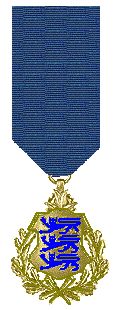
Order of the National Coat of Arms
Encyclopedia

Konstantin Päts
Konstantin Päts VR I/1 and III/1 was the most influential politician of interwar Estonia. He was one of the first Estonians to become active in politics and started an almost 40-year political rivalry with Jaan Tõnisson, first through journalism with his newspaper Teataja, later through politics...
on 7 October 1936 to commemorate 24 February 1918, the day on which Estonia
Estonia
Estonia , officially the Republic of Estonia , is a state in the Baltic region of Northern Europe. It is bordered to the north by the Gulf of Finland, to the west by the Baltic Sea, to the south by Latvia , and to the east by Lake Peipsi and the Russian Federation . Across the Baltic Sea lies...
n independence was declared. The Order of the National Coat of Arms is bestowed only on Estonian citizens, as a decoration of the highest class for services rendered to the state.
Classes
The Order of the National Coat of Arms comprises six classes:- One special class – the Collar of the Order of the National Coat of Arms;
- Five basic classes – 1st, 2nd, 3rd, 4th and 5th class.
The greater national coat of arms as part of the decorations of all the classes of the Order of the National Coat of Arms, goldplated on both sides, bears on its reverse the embossed date "24. II 1918". The colour tone of the blue moiré ribands belonging to the decorations of all the classes of the Order of the National Coat of Arms is determined according to the international PANTONE
Pantone
Pantone Inc. is a corporation headquartered in Carlstadt, New Jersey, USA. The company is best known for its Pantone Matching System , a proprietary color space...
colour-table as 285 C.
Collar
The collar of the Order of the National Coat of Arms is a badge of the office of the President of EstoniaPresident of Estonia
The President of the Republic is the head of state of the Republic of Estonia.Estonia is a parliamentary republic, therefore President is mainly a symbolic figure and holds no executive power. The President has to suspend his membership in any political party for his term in office...
. Until 2008, the collar was unique. As, however, Russians during the Soviet occupation had taken that collar to the Armory Chamber
Kremlin Armoury
The Kremlin Armory is one of the oldest museums of Moscow, established in 1808 and located in the Moscow Kremlin .The Kremlin Armoury originated as the royal arsenal in 1508. Until the transfer of the court to St Petersburg, the Armoury was in charge of producing, purchasing and storing weapons,...
(Оружейная палата, Oruzhejjnaja palata) in the Moscow Kremlin
Moscow Kremlin
The Moscow Kremlin , sometimes referred to as simply The Kremlin, is a historic fortified complex at the heart of Moscow, overlooking the Moskva River , Saint Basil's Cathedral and Red Square and the Alexander Garden...
as a trophy and never have returned the collar to Estonia, a newly made copy is again worn by the President of Estonia as a badge of office. http://www.president.ee/et/ametitegevus/ametlikud_teated.php?gid=109326
Special sash
Special sash (Riigivapi teenetemärgi erisuurpael) was received by Konstantin PätsKonstantin Päts
Konstantin Päts VR I/1 and III/1 was the most influential politician of interwar Estonia. He was one of the first Estonians to become active in politics and started an almost 40-year political rivalry with Jaan Tõnisson, first through journalism with his newspaper Teataja, later through politics...
after his accession to the post of the President of the Republic.
See also
:Category:Recipients of the Order of the White Star- Estonian State DecorationsEstonian State DecorationsEstonian state decorations, their classes and descriptions, as provided by the State Decorations Act passed in the Riigikogu on 11 December 1996.* Cross of Liberty* Order of the National Coat of Arms* Order of the Cross of Terra Mariana...
- Coat of Arms of EstoniaCoat of arms of EstoniaThe coat of arms of Estonia is a golden shield which includes three slim blue passant gardant lions in the middle, with oak branches along the side of the shield. The three lions derive from the arms of Danish king Valdemar II who had conquered northern Estonia in 1219...
- State decorationState decorationState decorations are orders, medals and other decorations granted by a state. International decorations are similar, but are not granted by a specific nation but rather an international organization....

